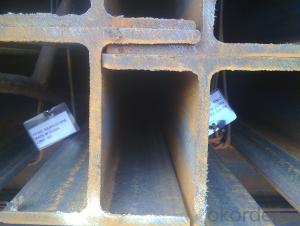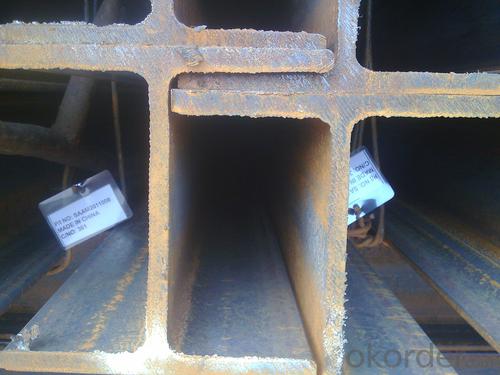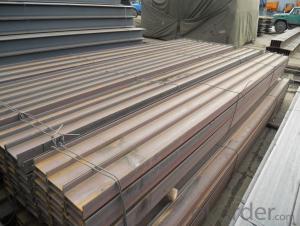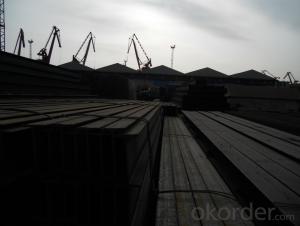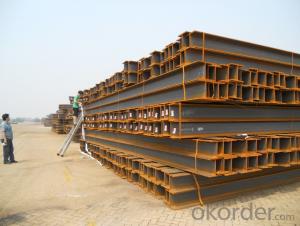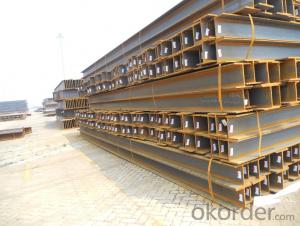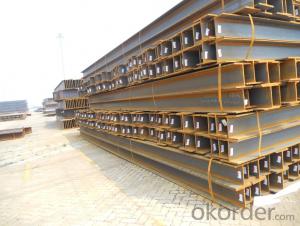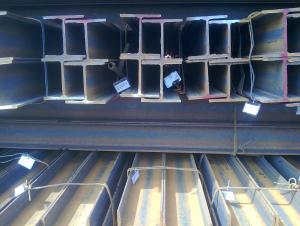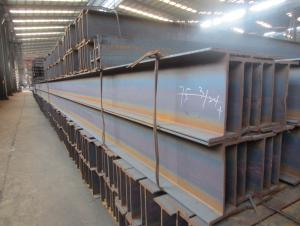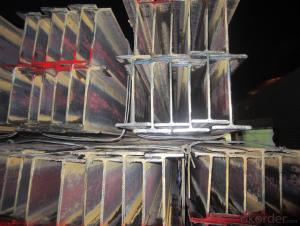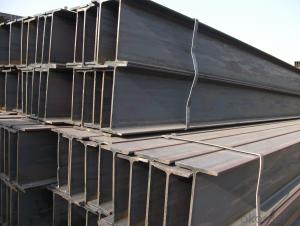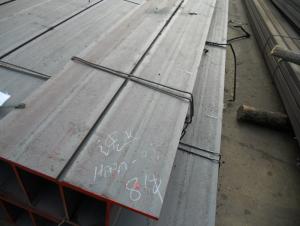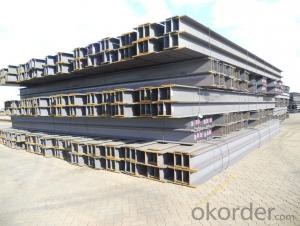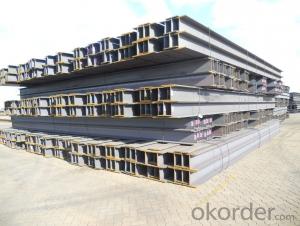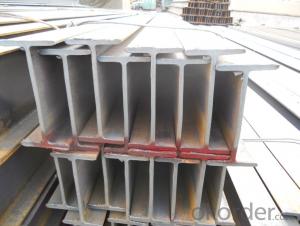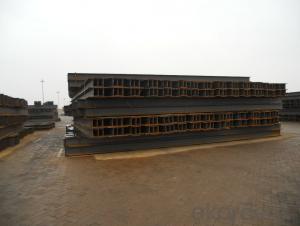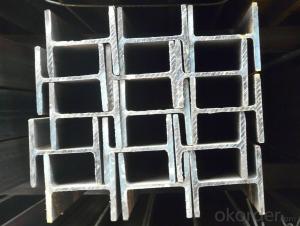JIS Standard Hot Rolled Steel H Beams of Steel Grade SS400
- Loading Port:
- Shanghai
- Payment Terms:
- TT or LC
- Min Order Qty:
- 25 m.t.
- Supply Capability:
- 200000 m.t./month
OKorder Service Pledge
OKorder Financial Service
You Might Also Like
Product Description:
OKorder is offering JIS Standard Hot Rolled Steel H Beams of Steel Grade SS400 at great prices with worldwide shipping. Our supplier is a world-class manufacturer of steel, with our products utilized the world over. OKorder annually supplies products to European, North American and Asian markets. We provide quotations within 24 hours of receiving an inquiry and guarantee competitive prices.
Product Applications:
JIS Standard Hot Rolled Steel H Beams of Steel Grade SS400 are ideal for structural applications and are widely used in the construction of buildings and bridges, and the manufacturing, petrochemical, and transportation industries. Commercial building structure ;Pre-engineered buildings; Machinery support structure; Prefabricated structure; Medium scale bridges; Ship-building structure. etc.
Product Advantages:
OKorder's JIS Standard Hot Rolled Steel H Beams of Steel Grade SS400 are durable, strong, and resist corrosion.
Main Product Features:
· Premium quality
· Prompt delivery & seaworthy packing (30 days after receiving deposit)
· Corrosion resistance
· Can be recycled and reused
· Mill test certification
· Professional Service
· Competitive pricing
Specifications of JIS Standard Hot Rolled Steel H Beams of Steel Grade SS400
1. Standard: JIS G3101
2. Grade: SS400 or Equivalent
3. Length: 6m,10m, 12m as following table
4. Invoicing on theoretical weight or actual weight as customer request
5.Payment: TT or L/C
6. Sizes:
SIZE(mm) | DIMENSION(kg/m) |
100*100 | 16.9 |
125*125 | 23.6 |
150*75 | 14 |
150*150 | 31.1 |
148*100 | 20.7 |
198*99 | 17.8 |
200*100 | 20.9 |
248*124 | 25.1 |
250*125 | 29 |
300*150 | 36.7 |
298*149 | 32 |
200*200 | 49.9 |
294*200 | 55.8 |
346*174 | 41.2 |
350*175 | 49.4 |
244*175 | 43.6 |
175*175 | 40.4 |
294*200 | 55.8 |
298*201 | 64.4 |
346*174 | 41.2 |
350*175 | 49.4 |
400*200 | 65.4 |
396*199 | 56.1 |
450*200 | 74.9 |
446*199 | 65.1 |
340*250 | 78.1 |
500*200 | 88.1 |
300*150 | 36.7 |
Packaging & Delivery of JIS Standard Hot Rolled Steel H Beams of Steel Grade SS400
1. Packing: it is nude packed in bundles by steel wire rod
2. Bundle weight: not more than 3.5MT for bulk vessel; less than 3 MT for container load
3. Marks:
Color marking: There will be color marking on both end of the bundle for the cargo delivered by bulk vessel. That makes it easily to distinguish at the destination port.
Tag mark: there will be tag mark tied up on the bundles. The information usually including supplier logo and name, product name, made in China, shipping marks and other information request by the customer.
If loading by container the marking is not needed, but we will prepare it as customer request.
4. Transportation: the goods are delivered by truck from mill to loading port, the maximum quantity can be loaded is around 40MTs by each truck. If the order quantity cannot reach the full truck loaded, the transportation cost per ton will be little higher than full load.
5. Delivered by container or bulk vessel
Production flow of JIS Standard Hot Rolled Steel H Beams of Steel Grade SS400
Material prepare (billet) —heat up—rough rolling—precision rolling—cooling—packing—storage and transportation
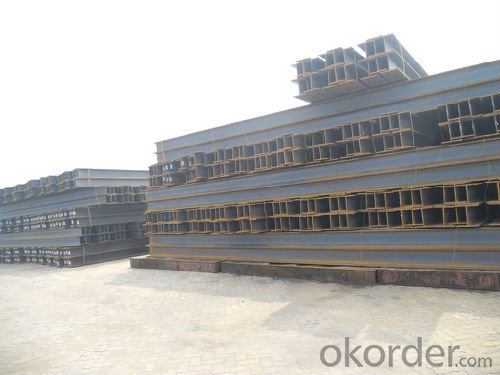
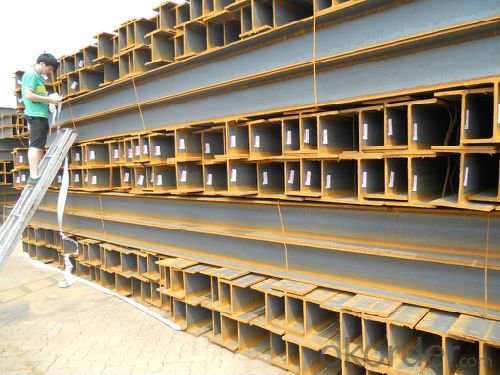
FAQ:
Q1: What is the normal tolerance of JIS Standard Hot Rolled Steel H Beams of Steel Grade SS400?
A1: Normally 3%-5%, but we can also produce the goods according to the customers' requests.
Q2: Can fit in the containers of 20fts the steel beams of 6M?
A2: No proble, we can put them into the containers in the form sideling.
Q3: The products are invoicing on theoritical weight or on actual weight?
A3: We can do it in both manners, according to the customers' request.
- Q: Are there any limitations or restrictions in using Steel H-Beams in construction?
- Yes, there are certain limitations and restrictions in using Steel H-Beams in construction. Some of these limitations include: 1. Size and weight restrictions: Steel H-Beams come in various sizes and weights, and there may be limitations on the maximum size or weight that can be used in a particular construction project. This is usually determined by the structural engineer who considers factors such as load-bearing capacity, deflection limits, and the overall design requirements. 2. Cost: Steel H-Beams can be more expensive compared to other construction materials such as wood or concrete. This cost factor may restrict their use in budget-constrained projects or where cost optimization is a priority. 3. Availability: Availability of Steel H-Beams may be limited in some regions, especially in remote areas where transportation costs can be prohibitive. This limitation may necessitate the use of alternative materials or different construction methods. 4. Design limitations: Steel H-Beams have specific design requirements that need to be met in order to ensure structural integrity. These include proper connections, bracing, and adequate spacing. Failure to meet these design requirements may lead to a weakened structure or compromised safety. 5. Fire resistance: Steel is not inherently fire-resistant and can lose its strength when exposed to high temperatures. Therefore, additional fire protection measures such as fire-resistant coatings or insulation may need to be considered when using Steel H-Beams in construction, particularly in buildings with specific fire safety regulations. 6. Environmental considerations: Steel production has a significant environmental impact due to the carbon emissions associated with its manufacturing process. In some cases, there may be restrictions or limitations on the use of steel in construction projects that prioritize sustainability or have specific environmental regulations. It is important to consult with a structural engineer and adhere to local building codes and regulations to ensure that the limitations and restrictions of using Steel H-Beams are properly considered and addressed in any construction project.
- Q: What are the safety precautions to consider when handling steel H-beams during installation?
- When handling steel H-beams during installation, there are several safety precautions to consider to ensure the safety of workers and prevent accidents: 1. Personal Protective Equipment (PPE): All workers involved in handling steel H-beams should wear appropriate PPE, including steel-toed boots, safety glasses, hard hats, and gloves. This will protect them from potential hazards such as falling beams or sharp edges. 2. Proper Lifting Techniques: It is important to use proper lifting techniques when handling steel H-beams to prevent strains or injuries. Workers should be trained on how to lift heavy objects using their legs, not their backs, and should avoid twisting or jerking motions during lifting. 3. Adequate Training: Only trained and experienced workers should handle steel H-beams during installation. They should be familiar with the weight and dimensions of the beams, as well as proper handling techniques. Inexperienced workers should always be supervised by someone with expertise in steel beam installation. 4. Secure Storage: Steel H-beams should be stored in a secure and stable manner to prevent them from falling or causing accidents. They should be stacked on a flat and level surface, with proper support underneath to prevent toppling. If beams are stored vertically, they should be secured with straps or other restraints to prevent them from falling. 5. Clear Communication: Effective communication is essential during the handling and installation of steel H-beams. Workers should use clear hand signals or verbal commands to coordinate movements and ensure everyone is aware of their surroundings. A designated spotter should be assigned to guide the crane operator or forklift driver during lifting and placement. 6. Inspection and Maintenance: Before using steel H-beams for installation, they should be thoroughly inspected for any defects or damage. Any beam that shows signs of cracks, warping, or other structural issues should not be used. Regular maintenance and inspection of lifting equipment such as cranes or forklifts are also crucial to ensure their safe operation. 7. Adequate Planning: Proper planning is key to ensuring the safe installation of steel H-beams. This includes evaluating the site conditions, determining the appropriate equipment for handling and lifting, and developing a detailed installation plan. Adequate planning allows for a systematic approach to minimize risks and ensure a safe work environment. By following these safety precautions, the risk of accidents and injuries during the installation of steel H-beams can be significantly reduced, creating a safer work environment for all involved.
- Q: How are steel H-beams specified in construction drawings?
- Steel H-beams are specified in construction drawings by providing detailed information about their dimensions, such as the height, width, and thickness of the flanges and web, as well as the overall length. The drawings also include information about the steel grade, tolerances, and any specific requirements for welding or connections. Additionally, the drawings may indicate the location and orientation of the H-beams within the structure, along with any necessary details or notations for installation.
- Q: What is the cost of steel H-beams compared to other structural materials?
- When comparing the cost of steel H-beams to other structural materials, it is evident that steel offers a competitive price. The construction industry widely utilizes steel due to its strength, durability, and versatility. While the specific cost may vary depending on factors such as size, grade, and market conditions, steel H-beams generally present a cost-effective solution for structural needs. In contrast to materials like wood or concrete, steel H-beams exhibit superior strength and load-bearing capacity. This quality allows for longer spans and fewer supporting columns, resulting in cost savings in terms of materials, labor, and construction time. Moreover, steel possesses high resistance to environmental factors like moisture, fire, and pests, consequently reducing long-term maintenance costs. Despite the potential fluctuations in steel prices due to market conditions, it remains a favored choice for structural applications due to its availability and competitiveness. When considering the cost of steel H-beams, it is crucial to evaluate other factors such as project requirements, design considerations, and overall budget to determine the most suitable and cost-effective solution.
- Q: H steel column calculationHow do you calculate the amount? And what are the steps and formulas for this calculation?
- The flange of the I-beam is variable cross section, the thickness of the web is thin and the outside is thin. The flange of H steel is equal section HWHMHNH. It is the general name of H steel
- Q: Model H is 580*280*12*14. How much is the theoretical weight of the steel?It's better to list the complete formula, thank you!
- Quality = volume * density, the density of steel, 7.85g/cm3,0.785 is a fast algorithm, the essence should be: unit weight =144.64cm2*100cm*7.85g/cm3=113542.4g=113.54kg. 0.785=100*7.85/1000.
- Q: What are the different types of steel H-beam connections used in bridge design?
- Bridge design commonly utilizes multiple types of steel H-beam connections to ensure stability and integrity. The following connection types are frequently employed: 1. Welded Connections: The most prevalent connection type involves melting and fusing H-beams together. Welded connections offer exceptional strength and rigidity, making them suitable for various bridge types. 2. Bolted Connections: High-strength bolts are used to connect H-beams, providing flexibility for disassembly and maintenance. However, bolted connections may not offer the same strength and rigidity as welded connections. 3. Riveted Connections: Previously common but now rare, riveted connections employ steel rivets to join H-beams. While providing good strength and durability, they can be time-consuming and expensive to install compared to other methods. 4. Moment Connections: These connections are utilized to transfer bending moments between H-beams. They offer high rigidity and are often used in bridge designs anticipating large loads or forces. 5. Shear Connections: Designed to transfer shear forces between H-beams, these connections are crucial for the bridge's stability and integrity, particularly in areas with significant horizontal forces. 6. Composite Connections: Composite connections combine steel H-beams with materials like concrete or timber. These connections provide the benefits of both materials, with steel offering strength and the additional material providing desirable properties like fire resistance or aesthetics. Ultimately, the choice of H-beam connection type depends on factors like bridge design, load requirements, and construction methods. Each type has its own advantages and limitations, and the selection should consider the specific needs and considerations of the bridge project.
- Q: Are steel H-beams suitable for commercial or industrial buildings?
- Commercial and industrial buildings often utilize steel H-beams for their numerous benefits. The first advantage is the excellent structural support and ability to bear heavy loads, making them suitable for large-scale constructions like warehouses, factories, and office complexes. With their high strength-to-weight ratio, longer spans and taller structures can be constructed, maximizing usable space while minimizing the need for additional columns. Furthermore, steel H-beams possess durability and resistance to various environmental factors, including fire, moisture, and pests. They also offer design flexibility, enabling easy modifications and expansions in the future. Additionally, steel is a sustainable and recyclable material, making it an environmentally conscious choice for construction. Overall, steel H-beams are a dependable and cost-effective solution for commercial and industrial buildings, ensuring both structural integrity and design versatility.
- Q: Can steel H-beams be used in seismic zones?
- Yes, steel H-beams can be used in seismic zones. Steel is a popular material choice for seismic construction due to its strength, flexibility, and ductility. H-beams, also known as I-beams, provide excellent structural support and can withstand the forces generated during seismic events. To ensure the safe use of steel H-beams in seismic zones, it is important to follow specific design and construction guidelines. These guidelines include factors such as selecting the appropriate material grade, size, and shape of the beams, as well as proper connection and reinforcement detailing. Design considerations such as the beam's moment of inertia, section modulus, and rigidity play a crucial role in determining the beam's ability to resist seismic forces. Additionally, the connections between the beams and other structural elements should be designed to accommodate the potential lateral and vertical movements that can occur during an earthquake. It is also important to comply with local building codes and regulations specific to seismic zones. These codes typically outline specific design parameters, construction techniques, and materials requirements to ensure structures can withstand seismic activity. By following these guidelines and adhering to local building codes, steel H-beams can be effectively used in seismic zones, providing a safe and reliable structural solution.
- Q: What are the different types of steel H-beam connections used in high-rise buildings?
- There are several types of steel H-beam connections commonly used in high-rise buildings. These include bolted connections, welded connections, and hybrid connections. Bolted connections involve using bolts and nuts to connect the H-beams together. Welded connections, on the other hand, involve welding the H-beams together to create a strong and rigid connection. Hybrid connections combine both bolted and welded connections, utilizing the advantages of both methods. The choice of connection type depends on factors such as structural requirements, load-bearing capacity, and construction feasibility.
Send your message to us
JIS Standard Hot Rolled Steel H Beams of Steel Grade SS400
- Loading Port:
- Shanghai
- Payment Terms:
- TT or LC
- Min Order Qty:
- 25 m.t.
- Supply Capability:
- 200000 m.t./month
OKorder Service Pledge
OKorder Financial Service
Similar products
Hot products
Hot Searches
Related keywords
